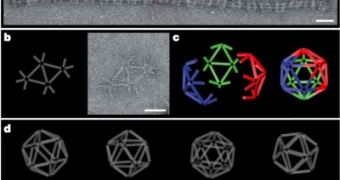Harvard Medical School (HMS) experts announced in the Wednesday issue of the scientific journal Nature that they'd managed to create 3-dimensional constructs in the lab, using nothing but pieces of DNA for the job. Their structures have been made in intricate shapes, and rely solely on the acid's ability to stick together only in certain configurations. The innovation opens up new possibilities for the field of personalized nanomedicine, as experts could soon devise carrier systems making use of the new method, which could carry vaccines to otherwise inaccessible places.
The new paper, co-authored by HMS Molecular Biologist William Shih, explains that the research team do not use the DNA for its genetic information at all. Rather, they tried to generate sequences of the acid in certain configurations. It's widely known that the four components of DNA, adenine (A), thymine (T), cytosine (C), and guanine (G) only bind in pairs of two – A to T and C to G, Wired reports. Making use of this information, the HMS scientists were able to synthesize strands of DNA sporting various configurations of the four “letters.”
When two strands created specifically to attach to each other were placed in close proximity, they combined based on the attraction exerted by the letters. But the position of the letters inside the strands is essential in determining the shape of the final construct. And, by combining two or three strands at the same time, they managed to create 3D structures, which could eventually be filled with vaccine molecules, or other such components. “Imagine that you could encode different charge patterns on your Lego bricks, so that they only fit together in a very specific manner. We make linear sequences of DNA, throw them into a pot, and let them find each other,” Shih explained.
“Imagine those Lego bricks are limited to thin bricks [which cannot be placed on top of each other]. You could build wireframe 3-D objects, where each strut was just one of those thin strips, but what we’ve done is create multi-layer bricks. With our technology, we can get greater rigidity. We can create very detailed pockets, because the structure has depth,” the expert added. “We’d like to build larger and larger structures. It’s like the evolution of integrated circuit microprocessors. We’ve been able, over time, to increase the number of transistors on each circuit. We’d like to follow the same trajectory with molecularly engineered objects.”
“Hierarchical structures, constructed from several repeating subunits, are a much sought-after goal of nanotechnology,” Duke University DNA Engineer Thomas LaBean, who has not been part of the current research, concluded in a Nature commentary.

 14 DAY TRIAL //
14 DAY TRIAL //